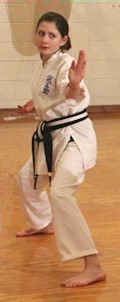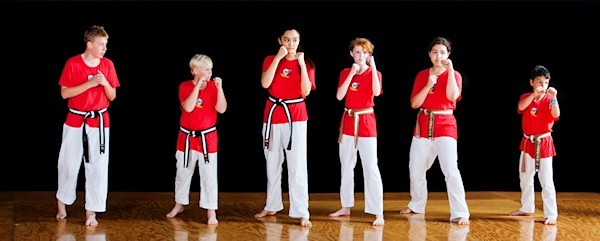2020 February
2018 December August June February
2017 December September June March
2016 November August June March
2015 December October July May February
2014 December October July April February
2013 December October August May February
2012 December September July April February
2011 December September July April February
from the February, 2014 issue of Kiai!
Bridging the Gap: The TW Teen Program
by Senpai Ana Gore
Junior 1st Degree Black Belt

Senpai Ana
We all know that when you reach about 13 your life becomes much busier. You rush around from place to place trying to get everything done. Some teens go directly from one after-school activity to another. One of my afternoons often consists of the following schedule:
3:30-4:45 Book club
4:50-5:25 Homework, part 1
5:45-6:45 Karate
6:50-7:15 Homework, part 2
7:15-8:00 Dinner
Many of my friends have similar schedules, often with even more activities. This is also difficult when you are a karateka (as many of you may know). Karate requires a regular training schedule, strict discipline, and training both in and out of the dojo because more than anything else, it’s a way of life. Some people even end up quitting because they just don’t have the time. Although sad, it is often reasonable considering how busy their schedules have become. These issues are mainly due to homework, and I’ve never had this much homework until going to middle school. And we all know, it’s only going to get worse...

Teens performed in Art With Heart, during Spirit Challenge in June, 2013.
But despite all of these challenges, Thousand Waves has a thriving and lively Teen program. In fact it has over 50 members. Most members are between the ages of twelve and seventeen, but seeing as there are so many junior black belts under the age of twelve, the young junior black belts (some only nine years old) get to train in the Teen program so they can learn curriculum with others at their level.

Teens work on the finer points of Pinan 2.
One thing teen members believe makes the Teen program special is the community. When talking to other teen members about the program, many spoke of the friendships they had made. Some of my closest friends are those I met through Thousand Waves. Although I made many friends in the Youth program when I was younger, the Teen program is smaller and more tightly knit. In the Teen program, everybody is friends, whereas in the Youth program that is less possible because there are so many children.

Teen class provides junior black belts an opportunity to learn to use weapons.
When you are an older teen, you can also train in the Adult program. Some advantages of training in both programs include that you have more options, and you can take more classes. On the other hand, training with children your own age is also good. If you’re a younger teen, you could also train in the Youth program. Training in three programs more than triples your options. Whether training in multiple programs or not, junior black belt Stella Ljung believes that “Everybody can learn their own materials” in the Teen program.
Through thick and thin and busy or not, the Teen program is a place where I feel safe and am allowed to be myself with people I enjoy while doing things I enjoy.
